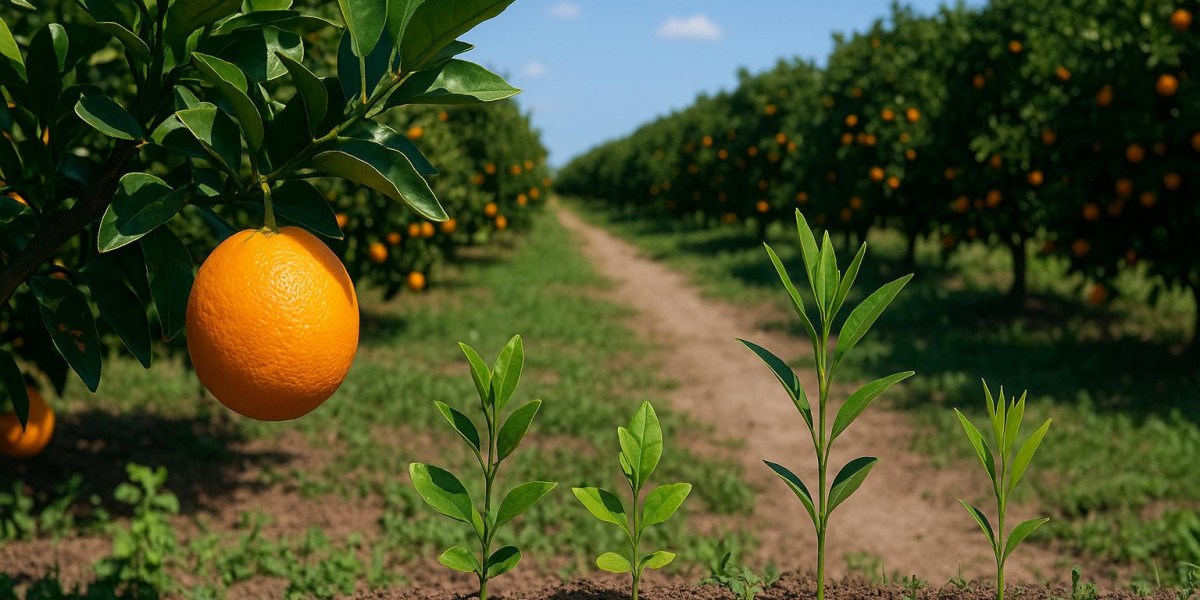For decades, the standard practice in citrus farming has been built on a simple triad: nitrogen, phosphorus, and potassium—better known as NPK. These primary macronutrients form the bedrock of crop nutrition, and rightly so. But lately, more and more citrus growers are rethinking this long-held reliance on NPK-only regimes. Why? Because good growth doesn’t always mean good fruit. And in many cases, NPK-heavy programs deliver size but not quality, volume but not value.
Orchards are clearly moving away from traditional methods and toward more specialized, micronutrient-inclusive ones. Furthermore, it's not a fad. It is a reaction to the need for higher-quality fruit in domestic and international markets, deteriorating soil health, and erratic weather patterns.
The Limits of NPK: What It Can't Fix
NPK fertilizers play crucial roles:
Nitrogen drives leaf and shoot growth
Phosphorus supports root development and flowering
Potassium aids in fruiting and disease tolerance
However, relying solely on these three nutrients assumes that other elements are either present in the soil or unnecessary, which couldn’t be further from the truth.
Citrus trees require a more comprehensive range of nutrients to thrive. When deficiencies go unnoticed or untreated, problems creep in:
Uneven fruit sizing despite good canopy development
Yellowing between leaf veins (interveinal chlorosis)
Poor flavor intensity and thin rinds
Premature fruit drop or cracking
The absence of NPK is not the cause of these. They stem from low concentrations of trace elements such as iron, manganese, boron, magnesium, and zinc.
Zinc, for instance, affects the enzyme systems that control fruit size and shoot elongation. Fruit set and pollination depend on boron. Citrus trees look green and developing without them, but they don't yield fruit that is suitable for the market.
Many seasoned farmers now add customized nutrition blends to their plans in order to directly address these gaps. Purchasing Arka Citrus Micronutrient Fertilizer, which provides crop-specific trace elements in an accessible form, is a wise first move for citrus producers who are experiencing ongoing problems with fruiting or blooming. Without overdoing the soil, this method guarantees steady development and improved fruit quality.
What Field Data Is Telling Us
The shift away from NPK-only is supported by tissue analysis and trials, not just farmer rhetoric. Citrus trees that received balanced vitamin supplementation yielded 20–35% more marketable fruit than those that received NPK alone, according to studies from the National Research Centre for Citrus.
Growers using a full-spectrum foliar micronutrient combination in Nagpur reported the following results in a 2022 field trial:
27% higher average fruit weight
18% reduction in fruit drop
32% improvement in rind firmness and juice content
And here's where it gets interesting: these gains came without increasing NPK inputs. This proves that better results don’t always require more fertilizer—just smarter fertilizer.
Soil Health and Nutrient Lock-Up
Soil chemistry is another reason why NPK-only feeding is insufficient. Particularly in India and some regions of the Middle East, citrus groves frequently experience excessive pH levels or unbalanced calcium-to-magnesium ratios. Even if micronutrients are available in the soil, they often become insoluble, which prevents the plant from absorbing them.
Additionally, excessive phosphorus consumption can counteract the absorption of zinc and iron, leading to noticeable deficiencies. Traditional fertilizer regimens become less effective due to this lock-up effect. The issue is then exacerbated when growers inadvertently apply extra NPK.
By supplying nutrients directly to leaves, where absorption is quicker and more consistent, foliar sprays of micronutrients circumvent this problem. It's a strategy, not a substitute.
"A lush green canopy doesn’t mean your trees are well-fed. Look at the fruit, not just the foliage." – Neeraj Bhosale, citrus grower and farm advisor
Market Demands Are Changing
Gone are the days when size alone sold fruit. Today’s markets want citrus that:
Stores well for export
Has a firm peel with a high juice-to-rind ratio
Features strong flavor, aroma, and shelf appeal
All of these qualities are influenced by micronutrients. For instance:
Calcium strengthens peel texture and prevents post-harvest rot
Magnesium boosts sugar transport, improving taste
Iron and manganese contribute to uniform fruit color
When given the proper micronutrient profile, a healthy citrus tree produces not just more but better. Farm revenue is strongly impacted by this, especially when selling to upscale retail chains or export aggregators.
Micronutrient Strategies That Work
So what does a successful citrus nutrient strategy look like today? It’s about timing, formulation, and delivery method. Some best practices include:
Pre-flowering sprays with zinc, boron, and magnesium to promote strong blooms
Mid-season foliar feeding with iron and manganese for green canopy maintenance and sugar formation
Post-fruit set calcium applications to improve peel strength and prevent splitting
When compared to applications of individual micronutrients, blended micronutrient formulations save time and effort. Additionally, they are less likely to have nutrient antagonistic effects.
Growers who use citrus-specific mixes report improved tree recovery following stress events like drought or pruning, fewer post-harvest losses, and a decreased need for corrective treatments.
Sustainability and Reduced Chemical Dependency
Improved plant immunity is one of the negative effects of abandoning NPK-only regimens. Plant defense mechanisms are activated by trace elements like copper and manganese, which lessen vulnerability to bacterial and fungal diseases.
As a result, some growers are using fewer pesticides during fruit development. Trees are less vulnerable to opportunistic diseases and abrupt decline when micronutrients are present to strengthen plant tissues and enhance internal balance.
Additionally, smart feeding reduces input waste, chemical runoff, and environmental stress on the orchard ecosystem, all of which are integral to a broader sustainable agricultural paradigm.
The FAO’s Integrated Plant Nutrition System highlights micronutrient use as a pillar of low-impact, high-efficiency farming. For citrus growers, that translates to healthier fruit with fewer chemical inputs.
FAQs
Can I mix micronutrients with my existing NPK fertilizer?
It depends. Some products are designed for tank-mixing, others aren’t. Always check compatibility and avoid applying micronutrients at the same time as high-phosphorus NPK, which can cause absorption issues.Is foliar application better than soil drenching?
For micronutrients, yes. Soil drenching is often inefficient due to nutrient lock-up in alkaline soils. Foliar sprays deliver nutrients directly where the plant needs them.Will micronutrients replace NPK?
No. Think of them as complementary. NPK provides bulk nutrients, while micronutrients fine-tune plant functions and fruit quality.How can I know which micronutrients my orchard needs?
Leaf tissue testing during pre-flowering and mid-fruiting stages gives an accurate picture. Visual signs are useful, but not always reliable.Are micronutrients effective for organic citrus farms?
Yes, as long as you use organically approved formulations. Many chelated micronutrient products now meet organic standards.
What Growers Are Realizing—And What You Can Do
The NPK-only model had its time. It supported generations of farming with straightforward, scalable solutions. But modern citrus farming is more demanding. With tighter margins, higher market expectations, and shifting climate conditions, farmers can’t afford to ignore the details anymore.
Today's most successful producers are those who apply more intelligently rather than more frequently. They are precisely adding micronutrients, monitoring the health of the leaves, and modifying spray schedules.
Therefore, it could be necessary to go beyond the essentials if your orchard is productive but not profitable, or green but not great. Examine the effects of micronutrient-focused nutrition on your crop's long-term health and market potential in addition to yield.
greater balance, not more fertilizer, is the first step toward greater fruit. And balance is key when it comes to citrus.








